Taiwanese NAS manufacturer QNAP Systems held a product launch on November 20. In addition to announcing consumer products and high-performance products for production and companies, the event was a rich event, including the details of the latest version of the original OS “QTS” used in the company's NAS ( http: // internet.watch.impress.com/docs/news/20151124_731858.html ).
Prior to that, we had the opportunity to interview Teddy Kuo, CEO of the company, at Tech Wind, one of the Japanese distributors of QNAP products. We asked about the company's enthusiasm for the Japanese market, which has rapidly introduced high-performance, high-quality NAS, and future developments.
Teddy Kuo, CEO of Taiwan QNAP Systems
Dual OS for more users
――Please tell us from the first story. First of all, why did you decide to enter the Japanese market and what is the appeal of the Japanese market in the storage system field?
Japan is an advanced country and a very important market for us. The movements such as IoT and Industry 4.0 have been active in books today, but I would like to emphasize that our QNAP NAS products can provide various applications and functions for them. I think.
In addition, as we will talk about at a subsequent presentation, the new QNAP NAS will release not only the original OS QTS but also a dual OS with Android, so more people and more power users I think it will be used by many companies.
And the Japanese market is very attractive. All industries are automated. For example, there are places where not only factories but also services are automated. Everything is automatic and everywhere is connected to the internet. QNAP's NAS believes that it will play a big role in the market where such automation is progressing and connected to the network. Our products act as gateways and storage, from applications and sensors to the cloud on the internet.
In addition, I think that users of these advanced countries such as Japan will like QNAP's NAS products in particular and use them more in the future.
――Please tell us about the position of the new product to be announced and its aim.
Among the 3 main products announced today, there is a product called “TAS-168 / 268”. This is equipped with a conventional QTS and Android dual OS. Android is an operating system that is already widely used in the market centering on smartphones, and more than 2 million apps are registered in the Google Play app store and can be downloaded freely. In other words, the aim is to increase the number of people who can use QNAP's NAS.
There are several other benefits of using Android. I think that general Android devices are not enough in capacity. Many smartphones have 16GB and 32GB, and even iPhones have a maximum of 128GB. NAS, on the other hand, can store 2TB or 4TB or more of storage lightly, so it is the same as having almost no limit on capacity.
The TAS-168 / 268 also has an HDMI terminal. So far, Android devices range from 5 inches to 12 inches on tablets, and the screen is small. Since TAS-168 / 268 can be connected to large displays such as 60-inch via HDMI, you can easily enjoy Android apps and games on a large screen. It also supports 4K resolution.
NAS "TAS-168 / 268" equipped with dual OS of QTS and Android
Connect to the display via the HDMI terminal
――Although functions have increased in terms of hardware, the original OS QTS has been updated many times and incorporated many functions. What is the idea behind QTS, adding and expanding functions?
QTS is a Linux kernel-based OS, and there are only about 100 dedicated applications. However, this time TAS-168, considering that we want more users and more people to use it. It is a dual OS that adds Android OS to / 268.
There is already a function called “Virtualization Station” in NAS for enterprises. By using this function, in addition to QTS, you can build an OS such as Windows in the NAS and access the data in the NAS from there, but such functions, anyway, to more people We have increased various functions to use it. In the future, I think it will become a dual OS for power users and enterprise NAS.
――What is the position of QTS in the future when Android is standardized?
"Qsirch" that can search full text of various files
With regard to QTS, we would like to proceed in two main directions. One is for entertainment use, ie for general users. Up until now, we have provided utility applications such as “Qfile” and “Qphoto” that can be easily used by general users. In the future, we will provide entertainment-aware apps such as karaoke apps. We are also considering that. You can enjoy it at home without going to the karaoke box. Karaoke content that unexpectedly requires storage space can also be an advantage that can be used with QNAP NAS.
The other is for the enterprise and IT sectors. For the enterprise and IT fields, we want to further advance data backup. Currently, there is an app called “Qsirch” for the backed up data, so that full text search can be done easily and quickly. Although it is already convenient and easy to use for data and data management, further evolution should be a product with great benefits for companies.
Conscious of IoT and big data. Established a Japanese subsidiary to strengthen support
Mr. Kuo speaks quietly, but I can see a strong will to increase Japanese users
-So far, QNAP has a slightly strong impression of consumer products in Japan, but what is the future trend for products for business enterprises?
"TVS-ECx80U-SAS" for enterprises
QNAP has become quite famous in the consumer market. But in fact, before the consumer, we focused on the enterprise. Today we are announcing the TVS-ECx80U-SAS as a new NAS for enterprises, but the successor models after that will be multiprocessor with two CPUs.
We intend to create an enterprise NAS that allows corporate users to store data at high speed and support big data in the future. Multi-CPU enterprise products will be released in December.
――There are several NAS vendors in Taiwan alone, and it is difficult for users to see the difference. Where does QNAP appeal as a differentiation point?
QNAP's NAS products differ from other manufacturers in that the standard OS QTS installed is based on the Linux kernel and is open source. Open source means that anyone can use it. And you can freely create apps and add them to QTS.
In the future, I would like to further evolve the product for IoT and big data. If you want to collaborate with OSs that are supported not only by QTS, but also by Ubuntu, Android, and many other apps. These points are what other manufacturers can't do, and we can say that this is the significance of our existence and our commitment to NAS.
-High performance and high performance are appealing to other NAS companies. Which part of QNAP is particularly superior to them?
For example, another NAS manufacturer in Taiwan seems to be a very wonderful manufacturer, but their product lineup is around $ 200 and the impression of focusing on general users is strong. QNAP, on the other hand, is designed to include performance, future OS development, expandability, supportability, and future prospects. Our main target is power users and companies. It uses a highly reliable CPU such as Intel Celeron or Atom, and is characterized by high-speed and stable operation.
-How do you appeal to the strengths of competing Japanese peripheral equipment manufacturers?
Japanese buffalo, I / O data equipment, ELECOM, etc. are also wonderful manufacturers. Japanese brand products are stable in quality and well known. We want to learn from those who have long experience in the Japanese market, not to compete with these Japanese manufacturers.
Thanks to you, QNAP was able to establish a Japanese subsidiary in Japan and set up a branch office. Starting in October and working with 5 people, we will continue to strengthen support for the Japanese market. We will support more agencies such as Tech Wind than ever.
――Are there any special features in the Japanese market and users compared to other countries?
QNAP's NAS sells all over the world, but what Japanese users and companies are most interested in feels that they are the newest, most powerful and stable products at that time. The I am thinking that we need to improve our skills more than ever.
Collaboration with group companies that are good at embedded devices
--How do you see the future potential of the Japanese market?
We QNAP NAS is not just a storage system. As I mentioned at the beginning, Japan is a very advanced country, so I believe that many people, such as companies and industries, can make full use of NAS data storage, backup, and other functions.
By the way, QNAP is a member of Taiwan iEi Group. iEi is known as a manufacturer of embedded devices for industrial use. For example, it manufactures POS / kiosk terminals and industrial factory automation devices. We have been providing various products to Japan for a long time.
We have supplied all kinds of “Smart XX” such as smart retail, smart factory, smart transportation, smart medical, etc. to the embedded market. It is ... is not it. I would like to actively expand into the Japanese market in collaboration with QNAP and iEi.
-QNAP, will you continue to focus on storage systems in the future? What about developing your own storage?
I don't think that HDD / SSD and other storage products will enter or develop. Rather, it is more important to increase the number of QTS apps, and to expand and expand apps through collaboration between OSs like dual OS. In cooperation with iEi, it may be possible to provide products that integrate QNAP NAS and embedded products to the Japanese market.
For example, the TVS-871T announced this time is a product equipped with Thunderbolt 2 that realizes a transfer speed of 20Gbps, uses Intel and Apple's solution, and supports iSCSI. Developed by taking advantage of its strengths.
"TVS-871T" with Thunderbolt 2 with 20Gbps transfer speed
2 Thunderbolt 2 and 10 Gigabit Ethernet ports
-Is it likely that you will develop products in partnership with specific HDD / SSD manufacturers in the future?
Although we may have a strong image of working with HDD manufacturer Seagate, Seagate is strong in the area of rack-mounted enterprise products such as "TVS-ECx80U-SAS" announced this time. right.
Seagate storage is the most stable and performable thing we've tested so far, so we're in a position to choose Seagate's advanced technology rather than partnering with Seagate. There will be no special collaboration with specific storage manufacturers in the future, and we hope to collaborate with any manufacturer.
-By the way, are there plans to release Thunderbolt 3 compatible products?
Thunderbolt 3 compatible products are currently being discussed with relevant companies and will be released. We are already working on development.
I want you to update to QTS 4.2 as soon as possible
――If general users and SMEs choose QNAP's NAS, which product would you recommend?
If you are a general user who has never used NAS, TAS-168 / 268 is recommended because it will take some time to become familiar with QTS. As I mentioned earlier, QTS and Android dual OS, this NAS has a very simple QTS function, and you will be able to use the Android that you are familiar with, so it should be easy to use.
For small and medium-sized businesses, I think it will be “TVS-x63 series”. This is an AMD quad-core CPU and has a built-in 10 Gigabit Ethernet card. Thanks to the 10 gigabit support, the network environment will be comfortable, and this series is relatively easy to buy, so I think that it can be accepted by many companies.
-By the way, how does the CEO himself use NAS?
What I do every day recently is to use a function called “Qsync” to back up PC data to the cloud and then use “Qsirch” to search the full text. Searching in the PC with the Windows search function is not very efficient, but searching with QNAP is really comfortable.
-Finally, if you have any message for users who already use QNAP NAS.
This is a very simple word, but please update to QTS 4.2 as soon as possible (laughs). Various new functions such as storage image snapshot function and Gmail backup function, which were requested by users, have been introduced.
Future QTS updates will also be related to hardware, but the goal is to provide more than five years after the launch of the model. Based on our long experience with embedded devices, our policy is to guarantee more than 5 years, preferably 7 years.

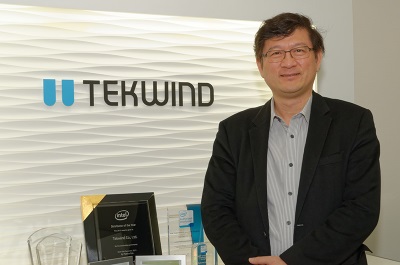

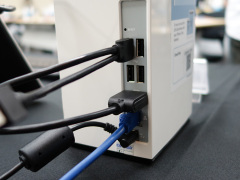
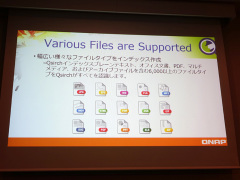


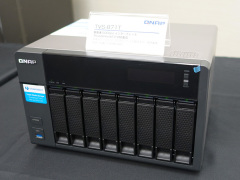
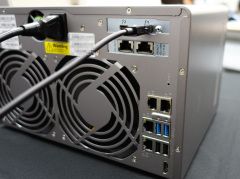

Comments
Post a Comment